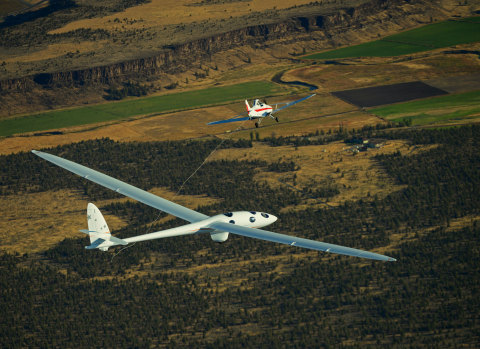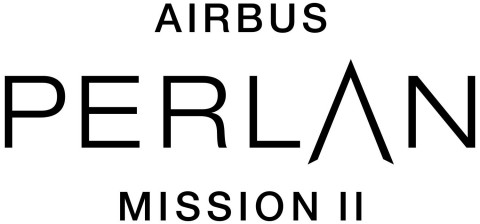REDMOND, Ore.--(BUSINESS WIRE)--The Perlan 2 glider, the world’s first engineless aircraft designed to reach the edge of space, achieved its successful first flight today in a historic moment about 5,000 feet above Robert’s Field, the Redmond Municipal Airport in Oregon. This was the first test flight of the aircraft, which next year will attempt to set a new world altitude record for any airplane. The goal of this project is to open up a world of new discoveries related to high-altitude flight, climate change and space exploration.
“Airbus Perlan Mission II is a historic endeavour in the truest spirit of aviation’s earliest pioneers,” said Tom Enders, Chairman and CEO of Airbus Group. “The knowledge gained from this project will impact how the world understands and addresses climate change. But it will also help Airbus continue to innovate ways to fly higher, faster and cleaner, on Earth and possibly beyond.”
The Perlan 2 glider was developed by The Perlan Project, a volunteer-run, non-profit endeavor headed by leaders in aerospace and engineering. It is supported by Airbus Group and a group of other sponsors that includes Weather Extreme Ltd., United Technologies and BRS Aerospace.
“We’re extremely excited about the successful first flight of the Perlan 2 glider,” said Ed Warnock, CEO of the Perlan Project. “This marks a major breakthrough in aviation innovation, one that will allow winged exploration of the atmosphere at the edge of space and lead to new discoveries to unravel some of the continuing mysteries of weather, climate change and ozone depletion.”
Jim Payne and Morgan Sandercock piloted today’s flight, which was the first of many for the Airbus Perlan Mission II team as it prepares to soar the aircraft to the edge of space in Argentina in 2016. The Perlan 2 is a pressurized sailplane designed to ride air currents that, in certain mountainous regions near the north and south poles, can reach into the stratosphere. Next year’s flights are expected to reach 90,000 feet, exceeding even the altitudes achieved by the U-2 and the SR-71.
Despite having no engine, the glider’s true flight speed at that altitude will be more than 400 mph and the air density will be less than two percent of what it is at sea level. The crew will breathe pure oxygen provided by a rebreather system, similar to what astronauts use in space.
In addition to its two-person crew, the aircraft carries scientific instruments to provide new insight into climate change and our upper atmosphere. Because it lacks an engine, Perlan 2 can explore the edge of space without polluting the atmosphere it will study, opening up human knowledge on several fronts:
- Understanding Weather – What happens at the highest levels of the stratosphere impacts weather around the globe, and Perlan 2 will be able to directly observe important atmospheric phenomena that previously have only been speculated about.
- Predicting Climate Change – Perlan 2 will collect and share data with atmospheric scientists worldwide, to improve climate models and more accurately predict climate change and its potential solutions.
- Diagnosing the Ozone Layer – Perlan 2 can take untainted air samples from the stratosphere to measure the levels of ozone-damaging chemicals and assess whether the ozone layer is replenishing or still depleting.
- Future of Aviation – Many of the high-altitude weather phenomena Perlan 2 will encounter have implications for aircraft performance and safety, especially as commercial aviation strives to operate aircraft at higher altitudes.
- Future of Space Travel – Perlan 2 will operate in atmospheric conditions roughly similar to those on Mars, providing insight into how wingborne aircraft could operate above the Martian surface.
For more information about the Airbus Perlan Mission II, please go to www.perlanproject.com.
Press Kit with images, infographic, fact sheet, and video is available at: www.airbusgroup.com/perlan
About Airbus Group, Inc.
Airbus Group, Inc. is the U.S.-based operation of Airbus Group, a global leader in aeronautics, space and related services. Airbus Group contributes more than $16.5 billion to the U.S. economy annually and supports over 250,000 American jobs through its network of suppliers.
Perlan’s other sponsors:
United
Technologies
Weather
Extreme Ltd.
BRS
Aerospace
Equipment, service and institutional donors:
Automated
Metal Products
Bonehead
Composites
Cobra
Trailer
Community
Foundation of Western Nevada
DeLorme
inReach
Epic
Aircraft
Garmin
Iridium
Communications Inc.
Miller
Nash Graham & Dunn
Sandia
Aerospace
Silicon
Valley Community Foundation
SIMCOM
SoaringNV
Soaring
Society of America
Trig
Avionics
Whelen
Engineering






